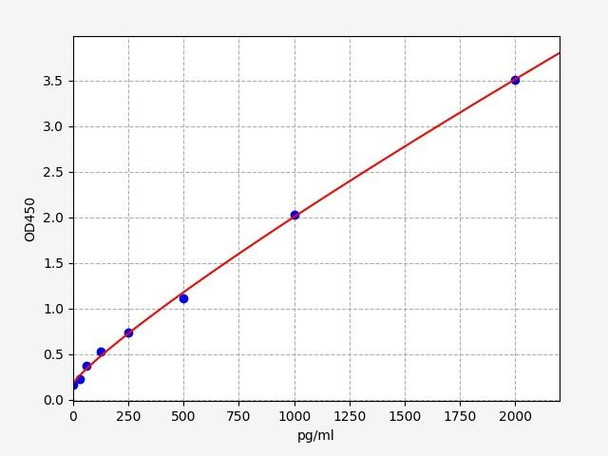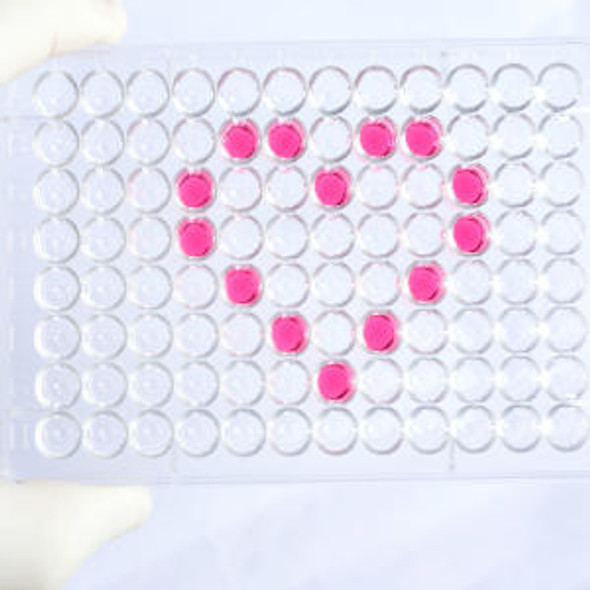Rat Immunology ELISA Kits 1
Rat Ectonucleotide pyrophosphatase / phosphodiesterase family member 1 / ENPP1 ELISA Kit
- SKU:
- RTFI00285
- Product Type:
- ELISA Kit
- Size:
- 96 Assays
- Uniprot:
- Q924C3
- Sensitivity:
- 18.75pg/ml
- Range:
- 31.25-2000pg/ml
- ELISA Type:
- Sandwich
- Synonyms:
- Enpp1, Phosphodiesterase I, nucleotide pyrophosphatase 1, Plasma-cell membrane glycoprotein PC-1,
- Reactivity:
- Rat
- Research Area:
- Signal Transduction
Description
| Product Name: | Rat Enpp1 (Ectonucleotide pyrophosphatase/phosphodiesterase family member 1) ELISA Kit |
| Product Code: | RTFI00285 |
| Size: | 96 Assays |
| Target: | Rat Enpp1 |
| Alias: | Enpp1, Phosphodiesterase I, nucleotide pyrophosphatase 1, Plasma-cell membrane glycoprotein PC-1 |
| Reactivity: | Rat |
| Detection Method: | Sandwich ELISA, Double Antibody |
| Sensitivity: | 18.75pg/ml |
| Range: | 31.25-2000pg/ml |
| Storage: | 4°C for 6 months |
| Note: | For Research Use Only |
| Recovery: | Matrices listed below were spiked with certain level of Rat Enpp1 and the recovery rates were calculated by comparing the measured value to the expected amount of Rat Enpp1 in samples. | ||||||||||||||||
| |||||||||||||||||
| Linearity: | The linearity of the kit was assayed by testing samples spiked with appropriate concentration of Rat Enpp1 and their serial dilutions. The results were demonstrated by the percentage of calculated concentration to the expected. | ||||||||||||||||
| |||||||||||||||||
| Intra-Assay: | CV <8% | ||||||||||||||||
| Inter-Assay: | CV <10% |
| Uniprot: | Q924C3 |
| UniProt Protein Function: | ENPP1: Involved primarily in ATP hydrolysis at the plasma membrane. Plays a role in regulating pyrophosphate levels, and functions in bone mineralization and soft tissue calcification. In vitro, has a broad specificity, hydrolyzing other nucleoside 5' triphosphates such as GTP, CTP, TTP and UTP to their corresponding monophosphates with release of pyrophosphate and diadenosine polyphosphates, and also 3',5'-cAMP to AMP. May also be involved in the regulation of the availability of nucleotide sugars in the endoplasmic reticulum and Golgi, and the regulation of purinergic signaling. Appears to modulate insulin sensitivity. Homodimer; disulfide-linked. Interacts with INSR. Expressed in plasma cells and also in a number of non-lymphoid tissues, including the distal convoluted tubule of the kidney, chondrocytes and epididymis. At low concentrations of ATP, a phosphorylated intermediate is formed which inhibits further hydrolysis. Belongs to the nucleotide pyrophosphatase/phosphodiesterase family. |
| UniProt Protein Details: | Protein type:Membrane protein, integral; Cofactor and Vitamin Metabolism - nicotinate and nicotinamide; Motility/polarity/chemotaxis; Nucleotide Metabolism - purine; Cofactor and Vitamin Metabolism - pantothenate and CoA biosynthesis; Phosphatase (non-protein); Carbohydrate Metabolism - starch and sucrose; Phosphodiesterase; EC 3.6.1.9; EC 3.1.4.1; Cofactor and Vitamin Metabolism - riboflavin Cellular Component: extracellular space; cell surface; integral to plasma membrane; basolateral plasma membrane; lysosomal membrane; extracellular region; integral to membrane; plasma membrane Molecular Function:phosphodiesterase I activity; nucleotide diphosphatase activity; protein homodimerization activity; nucleic acid binding; zinc ion binding; metal ion binding; calcium ion binding; nucleoside-triphosphate diphosphatase activity; scavenger receptor activity; ATP binding; insulin receptor binding; polysaccharide binding Biological Process: receptor-mediated endocytosis; sequestering of triacylglycerol; generation of precursor metabolites and energy; nucleoside triphosphate catabolic process; negative regulation of insulin receptor signaling pathway; negative regulation of fat cell differentiation; bone remodeling; phosphate metabolic process; 3'-phosphoadenosine 5'-phosphosulfate metabolic process; negative regulation of glucose import; cellular phosphate ion homeostasis; cellular response to insulin stimulus; biomineral formation; negative regulation of ossification; immune response; negative regulation of protein amino acid autophosphorylation; negative regulation of cell growth; inorganic diphosphate transport; negative regulation of glycogen biosynthetic process |
| NCBI Summary: | mutation of the human homolog is detected in patients with idiopathic infantile arterial calcification [RGD, Feb 2006] |
| UniProt Code: | Q924C3 |
| NCBI GenInfo Identifier: | 16758300 |
| NCBI Gene ID: | 85496 |
| NCBI Accession: | NP_445987.1 |
| UniProt Secondary Accession: | Q924C3,Q91XQ3, Q920C8, |
| UniProt Related Accession: | Q924C3 |
| Molecular Weight: | 102,843 Da |
| NCBI Full Name: | ectonucleotide pyrophosphatase/phosphodiesterase family member 1 |
| NCBI Synonym Full Names: | ectonucleotide pyrophosphatase/phosphodiesterase 1 |
| NCBI Official Symbol: | Enpp1 |
| NCBI Official Synonym Symbols: | Pc1; Npps |
| NCBI Protein Information: | ectonucleotide pyrophosphatase/phosphodiesterase family member 1 |
| UniProt Protein Name: | Ectonucleotide pyrophosphatase/phosphodiesterase family member 1 |
| UniProt Synonym Protein Names: | Phosphodiesterase I/nucleotide pyrophosphatase 1; Plasma-cell membrane glycoprotein PC-1Including the following 2 domains:Alkaline phosphodiesterase I (EC:3.1.4.1)Nucleotide pyrophosphatase (EC:3.6.1.9); NPPase |
| Protein Family: | Ectonucleotide pyrophosphatase/phosphodiesterase family |
| UniProt Gene Name: | Enpp1 |
| UniProt Entry Name: | ENPP1_RAT |
| Step | Procedure |
| 1. | Set standard, test sample and control (zero) wells on the pre-coated plate respectively, and then, record their positions. It is recommended to measure each standard and sample in duplicate. Wash plate 2 times before adding standard, sample and control (zero) wells! |
| 2. | Aliquot 0.1ml standard solutions into the standard wells. |
| 3. | Add 0.1 ml of Sample / Standard dilution buffer into the control (zero) well. |
| 4. | Add 0.1 ml of properly diluted sample ( Human serum, plasma, tissue homogenates and other biological fluids.) into test sample wells. |
| 5. | Seal the plate with a cover and incubate at 37°C for 90 min. |
| 6. | Remove the cover and discard the plate content, clap the plate on the absorbent filter papers or other absorbent material. Do NOT let the wells completely dry at any time. Wash plate X2. |
| 7. | Add 0.1 ml of Biotin- detection antibody working solution into the above wells (standard, test sample & zero wells). Add the solution at the bottom of each well without touching the side wall. |
| 8. | Seal the plate with a cover and incubate at 37°C for 60 min. |
| 9. | Remove the cover, and wash plate 3 times with Wash buffer. Let wash buffer rest in wells for 1 min between each wash. |
| 10. | Add 0.1 ml of SABC working solution into each well, cover the plate and incubate at 37°C for 30 min. |
| 11. | Remove the cover and wash plate 5 times with Wash buffer, and each time let the wash buffer stay in the wells for 1-2 min. |
| 12. | Add 90 µL of TMB substrate into each well, cover the plate and incubate at 37°C in dark within 10-20 min. (Note: This incubation time is for reference use only, the optimal time should be determined by end user.) And the shades of blue can be seen in the first 3-4 wells (with most concentrated standard solutions), the other wells show no obvious color. |
| 13. | Add 50 µL of Stop solution into each well and mix thoroughly. The color changes into yellow immediately. |
| 14. | Read the O.D. absorbance at 450 nm in a microplate reader immediately after adding the stop solution. |
When carrying out an ELISA assay it is important to prepare your samples in order to achieve the best possible results. Below we have a list of procedures for the preparation of samples for different sample types.
| Sample Type | Protocol |
| Serum: | If using serum separator tubes, allow samples to clot for 30 minutes at room temperature. Centrifuge for 10 minutes at 1,000x g. Collect the serum fraction and assay promptly or aliquot and store the samples at -80°C. Avoid multiple freeze-thaw cycles. If serum separator tubes are not being used, allow samples to clotovernight at 2-8°C. Centrifuge for 10 minutes at 1,000x g. Removeserum and assay promptly or aliquot and store the samples at-80°C. Avoid multiple freeze-thaw cycles. |
| Plasma: | Collect plasma using EDTA or heparin as an anti-coagulant. Centrifuge samples at 4°C for 15 mins at 1000 × g within 30 mins of collection. Collect the plasma fraction and assay promptly or aliquot and store the samples at -80°C. Avoid multiple freeze-thaw cycles.Note: Over haemolysed samples are not suitable for use with this kit. |
| Urine & Cerebrospinal Fluid: | Collect the urine (mid-stream) in a sterile container, centrifuge for 20 mins at 2000-3000 rpm. Remove supernatant and assay immediately. If any precipitation is detected, repeat the centrifugation step. A similar protocol can be used for cerebrospinal fluid. |
| Cell Culture Supernatant: | Collect the cell culture media by pipette, followed by centrifugation at 4°C for 20 mins at 1500 rpm. Collect the clear supernatant and assay immediately. |
| Cell Lysates: | Solubilize cells in lysis buffer and allow to sit on ice for 30 minutes. Centrifuge tubes at 14,000 x g for 5 minutes to remove insoluble material. Aliquot the supernatant into a new tube and discard the remaining whole cell extract. Quantify total protein concentration using a total protein assay. Assay immediately or aliquot and store at ≤ -20°C. |
| Tissue Homogenates: | The preparation of tissue homogenates will vary depending upon tissue type. Rinse tissue with 1X PBS to remove excess blood & homogenizein 20ml of 1X PBS (including protease inhibitors) and store overnight at ≤ -20°C. Two freeze-thaw cycles are required to break the cell membranes. To further disrupt the cell membranes you can sonicate the samples. Centrifuge homogenates for 5 mins at 5000xg. Remove the supernatant and assay immediately or aliquot and store at -20°C or-80°C. |
| Tissue Lysates: | Rinse tissue with PBS, cut into 1-2 mm pieces, and homogenize with a tissue homogenizer in PBS. Add an equal volume of RIPA buffer containing protease inhibitors and lyse tissues at room temperature for 30 minutes with gentle agitation. Centrifuge to remove debris. Quantify total protein concentration using a total protein assay. Assay immediately or aliquot and store at ≤ -20 °C. |
| Breast Milk: | Collect milk samples and centrifuge at 10,000 x g for 60 min at 4°C. Aliquot the supernatant and assay. For long term use, store samples at -80°C. Minimize freeze/thaw cycles. |






